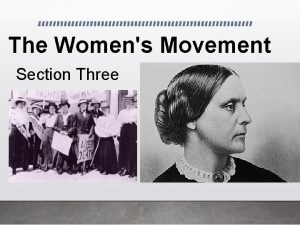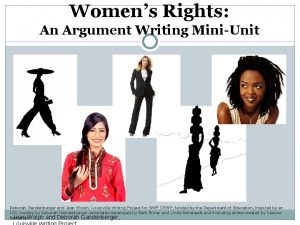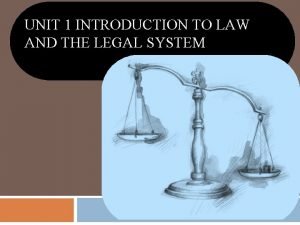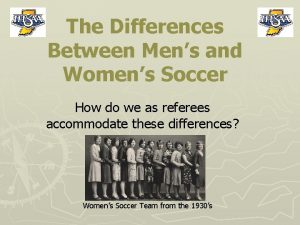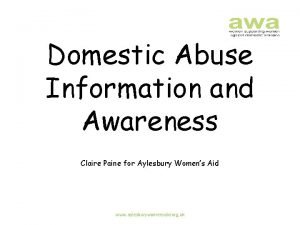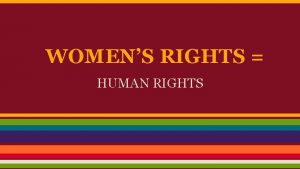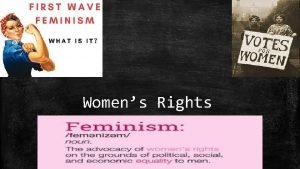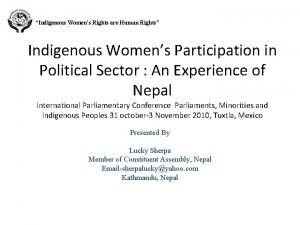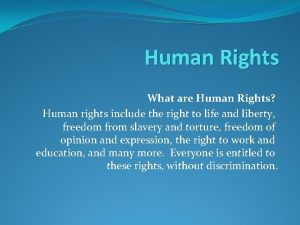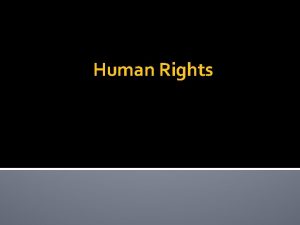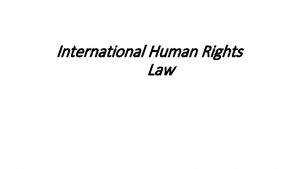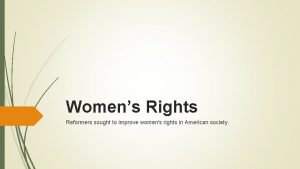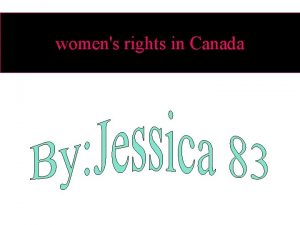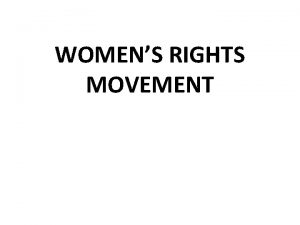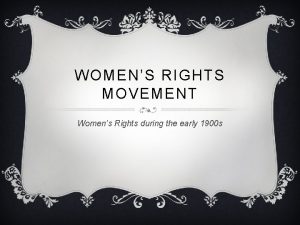Womens law and human rights Introduction to legal












- Slides: 12

Women’s law and human rights: Introduction to legal theory and methods Ingunn Ikdahl ingunn. ikdahl@jus. uio. no

Law & reality l Normative and descriptive questions: – – – l The role of facts – l Is discrimination prohibited? Should discrimination be prohibited? (Why) Does discrimination happen? Does this case constitute discrimination? Truth and authority

National law State Legislation Individual

International law State Treaty

International law – some phrases l Treaty, convention, covenant – Protocol l Declaration l Adoption, signature, ratification

International law - interpretation l General principles of international law exist: – – l Statute of the International Court of Justice Vienna Convention on the Law of Treaties International human rights law – treaty bodies and their documents

Statute of the International Court of Justice (ICJ), Art. 38 “ 1. The Court, whose function is to decide in accordance with international law such disputes as are submitted to it, shall apply: a. international conventions, whether general or particular, establishing rules expressly recognized by the contesting states; b. international custom, as evidence of a general practice accepted as law; c. the general principles of law recognized by civilized nations; d. subject to the provisions of Article 59, judicial decisions and the teachings of the most highly qualified publicists of the various nations, as subsidiary means for the determination of rules of law. ”

Vienna Convention on the Law of Treaties (1969), Arts. 31 -32 Article 31 (General rule of interpretation) “ 1. A treaty shall be interpreted in good faith in accordance with the ordinary meaning to be given to the terms of the treaty in their context and in the light of its object and purpose. 2. The context for the purpose of the interpretation of a treaty shall comprise, in addition to the text, including its preamble and annexes: (a) any agreement relating to the treaty which was made between all the parties in connection with the conclusion of the treaty; (b) any instrument which was made by one or more parties in connection with the conclusion of the treaty and accepted by the other parties as an instrument related to the treaty. 3. There shall be taken into account, together with the context: (a) any subsequent agreement between the parties regarding the interpretation of the treaty or the application of its provisions; (b) any subsequent practice in the application of the treaty which establishes the agreement of the parties regarding its interpretation; (c) any relevant rules of international law applicable in the relations between the parties. 4. A special meaning shall be given to a term if it is established that the parties so intended. ”

Vienna Convention on the Law of Treaties (1969), Arts. 31 -32 Article 32 (Supplementary means of interpretation) “Recourse may be had to supplementary means of interpretation, including the preparatory work of the treaty and the circumstances of its conclusion, in order to confirm the meaning resulting from the application of article 31, or to determine the meaning when the interpretation according to article 31: (a) leaves the meaning ambiguous or obscure; or (b) leads to a result which is manifestly absurd or unreasonable. ”

International human rights law – additional sources Convention CEDAW CCPR CESCR Committee X X X State reporting X X X Concluding observations X X Interpretations General Recommendation General Comment Individual complaints OP 1966 (in force 1976) OP 2008 (not in force yet) X OP 1999 (in force 2000)

Dynamic interpretation l Why are dynamic interpretations needed? – l How? – – l In women’s law in particular? ”discrimination”: intention, formal, indirect ”appropriate measures” Dynamics and controversies – – Tension between sources Maximum protection or retain legitimacy?

Human rights as national AND international law State Treaty Laws Individuals
 Conclusion of rights
Conclusion of rights Legal rights vs moral rights
Legal rights vs moral rights Womens rights
Womens rights Women's rights
Women's rights Unit 1 introduction to law and the legal system
Unit 1 introduction to law and the legal system Difference between mens and womens soccer
Difference between mens and womens soccer Newton's first law and second law and third law
Newton's first law and second law and third law Newton's first law and second law and third law
Newton's first law and second law and third law Positive vs negative rights
Positive vs negative rights Negative right
Negative right Needs of adolescence
Needs of adolescence Late night womens hour
Late night womens hour Aylesbury womens aid
Aylesbury womens aid


